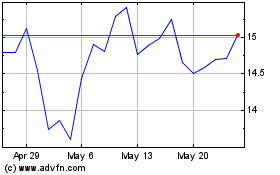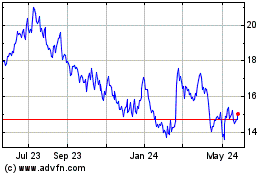Millions of Americans Experience Dry Eye Symptoms, Yet New National Survey Shows Sufferers Struggle to Find Relief
July 08 2024 - 7:00AM
Business Wire
New Online Resource, KnowYourDryEye.com,
Aims to Increase Awareness and Education
Bausch + Lomb Corporation (NYSE/TSX: BLCO), a leading global eye
health company dedicated to helping people see better to live
better, today shared results from the company’s inaugural State of
Dry Eye survey, which explores dry eye understanding and
experiences among American adults. Dry eye is increasingly common
and can range from occasional symptoms of dryness to a chronic
condition called dry eye disease. Although there is no cure for dry
eye, there are various options that can help people find
relief.
The survey revealed the majority of respondents may not know
that their symptoms – which can include redness, fluctuating
vision, a scratchy, gritty, tired or heavy feeling, or overall eye
irritation – may be associated with eye dryness. Additionally, most
respondents don’t realize that symptoms of dry eye are increasingly
present in younger people, and two in five are unaware that
untreated dry eye can lead to other eye problems, such as
fluctuating vision.
“The prevalence of dry eye is growing, particularly among a
younger demographic in large part due to modern lifestyles and
heavy digital device use,” said Yehia Hashad, MD, executive vice
president, Research & Development and chief medical officer,
Bausch + Lomb. “The survey results underscore the importance of
raising awareness of dry eye so sufferers are empowered to speak
with an eye care professional and seek relief. That’s why we
developed KnowYourDryEye.com to help facilitate these
conversations.”
Key Findings from the 2024 State of Dry
Eye Survey:
- Dry eye impacts quality of life.
- Three in four dry eye sufferers (75%) find it extremely or very
bothersome, with three in 10 saying that their symptoms have
worsened over time (31%).
- Eight in 10 dry eye sufferers (81%) are constantly aware of how
their eyes feel.
- Close to half of sufferers (46%) report that sometimes their
symptoms are so bad they can practically “hear themselves
blink”.
- And make it difficult to enjoy day-to-day activities.
- Most dry eye sufferers (67%) had to give up or cut back on
something to relieve symptoms, including screen time (32%),
spending time outdoors (25%) and wearing makeup (24%).
- Dry eye sufferers report their symptoms have the biggest impact
on reading (45%), device use (35%) and driving (31%).
- Despite this, most Americans don’t know much about dry eye,
what to do about it or that their symptoms may be associated with
dry eye.
- Most (70%) don’t know much about preventing or treating dry
eye.
- While respondents reported regularly experiencing symptoms that
may be related to dry eye, such as tired eyes [38%], sensitivity to
light [27%], and redness [19%]), fewer (15%) reported regularly
experiencing eye dryness, suggesting people may not recognize their
symptoms could be associated with dry eye.
- Around two in five Americans (43%) don’t routinely (i.e., at
least once a year) see an eye doctor, even though it’s the primary
way to get evaluated.
- Most respondents (66%) don’t know that symptoms of dry eyes are
increasingly present in younger people, which is likely the result
of today's modern lifestyles, including increased screen time.
- Over half of sufferers (52%) think dry eyes are difficult to
address and something people must learn to live with.
- If left untreated, dry eye may get worse and progress
to dry eye disease, potentially impacting eye health and
vision.
- More than two in five (44%) of respondents don’t know that
untreated dry eye can lead to other eye problems and even vision
loss.
“Most people think of dry eye as a minor nuisance, but the truth
is it can drastically affect one's daily life," said Rebecca
Petris, co-founder and president, Dry Eye Foundation. "Early
symptoms are often misunderstood, downplayed, ignored or
self-treated. People need to know their symptoms warrant a visit to
the eye doctor, so they can get an accurate diagnosis and
treatment. For people with dry eye, the good news is treatment and
symptom management options are available. People are finding
relief."
There are a broad range of options for those with dry eye, from
over-the-counter eye drops and nutritional supplements to
prescription medications. Those experiencing symptoms should see an
eye doctor to discuss what may be best for them. Learn more at
KnowYourDryEye.com.
About Dry Eye
Dry eye can be influenced by several factors, including
lifestyle, medications, hormonal changes, age, environment and
co-morbidities. It may be the result of the eyes not making enough
tears or making poor quality tears that evaporate too quickly. The
majority of those who progress to dry eye disease also have
underlying inflammation. There are a range of options for managing
dry eye symptoms, including over-the-counter eye drops,
prescription medications and nutritional supplements.
About the Survey
The research was conducted online in the United States by The
Harris Poll on behalf of Bausch + Lomb among 2,003 U.S. adults 18
years or older including 461 “sufferers” (defined as those who
often/always experience eye dryness and/or have been diagnosed by a
healthcare professional with dry eye disease) and 1,542
non-sufferers. “Respondents” or “Americans” refers to all 2,003
survey participants. The survey was conducted April 15-23,
2024.
Data are weighted where necessary by age by gender,
race/ethnicity, region, education, marital status, household size,
employment, household income, and political party affiliation to
bring them in line with their actual proportions in the
population.
Respondents for this survey were selected from among those who
have agreed to participate in our surveys. The sampling precision
of Harris online polls is measured by using a Bayesian credible
interval. For this study, the sample data is accurate to within ±
3.0 using a 95% confidence level. This credible interval will be
wider among subsets of the surveyed population of interest.
All sample surveys and polls, whether or not they use
probability sampling, are subject to other multiple sources of
error which are most often not possible to quantify or estimate,
including, but not limited to coverage error, error associated with
nonresponse, error associated with question wording and response
options, and post-survey weighting and adjustments.
About Bausch + Lomb
Bausch + Lomb is dedicated to protecting and enhancing the gift
of sight for millions of people around the world – from birth
through every phase of life. Its comprehensive portfolio of
approximately 400 products includes contact lenses, lens care
products, eye care products, ophthalmic pharmaceuticals,
over-the-counter products and ophthalmic surgical devices and
instruments. Founded in 1853, Bausch + Lomb has a significant
global research and development, manufacturing and commercial
footprint with approximately 13,000 employees and a presence in
nearly 100 countries. Bausch + Lomb is headquartered in Vaughan,
Ontario, with corporate offices in Bridgewater, New Jersey. For
more information, visit www.bausch.com and connect with us on X,
LinkedIn, Facebook and Instagram.
© 2024 Bausch + Lomb. BLNP.0114.USA.24
View source
version on businesswire.com: https://www.businesswire.com/news/home/20240708471165/en/
Media Contacts: Kristy Marks kristy.marks@bausch.com
(908) 927-0683
Caryn Marshall caryn.marshall@bausch.com (908) 493-1381
Investor Contact: George Gadkowski
george.gadkowski@bausch.com (877) 354-3705 (toll free) (908)
927-0735
Bausch plus Lomb (NYSE:BLCO)
Historical Stock Chart
From Dec 2024 to Jan 2025

Bausch plus Lomb (NYSE:BLCO)
Historical Stock Chart
From Jan 2024 to Jan 2025
